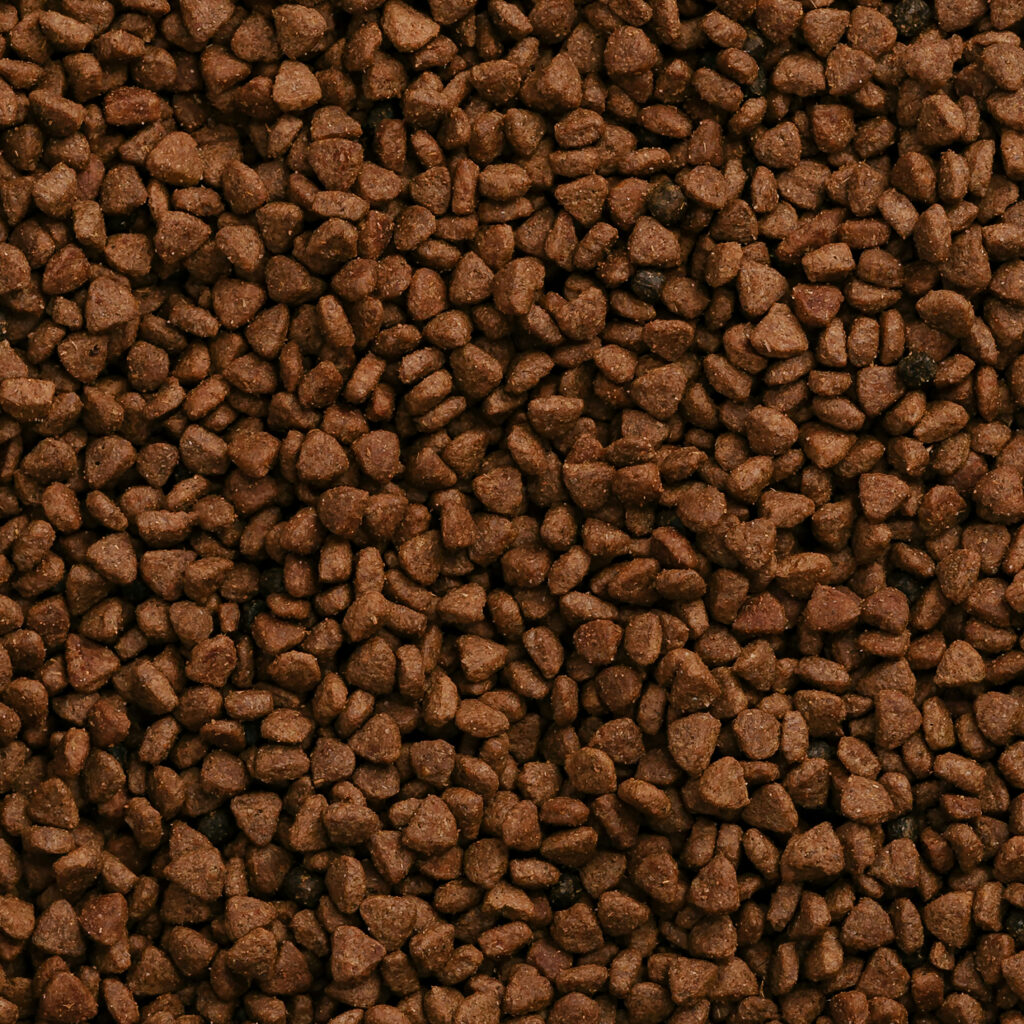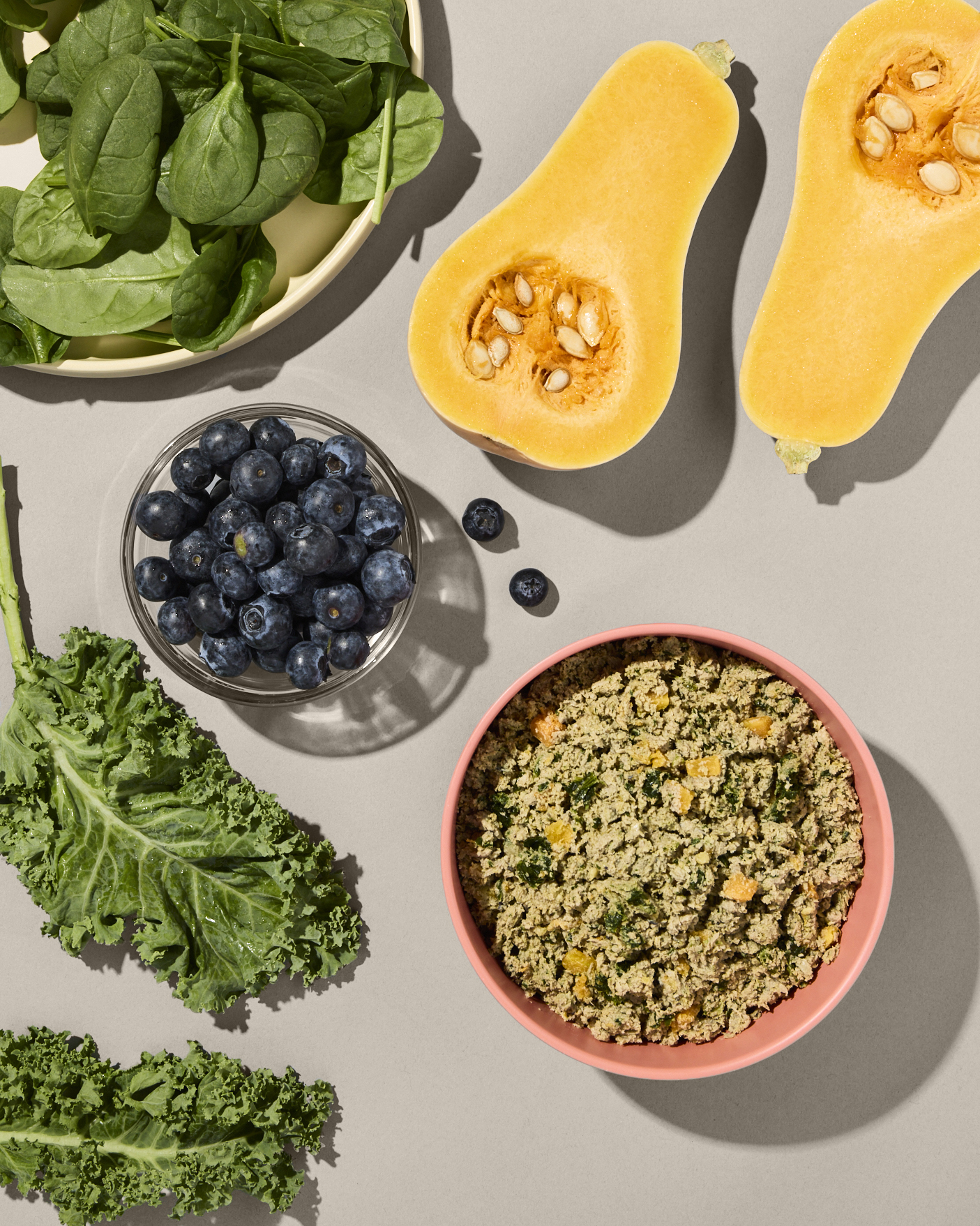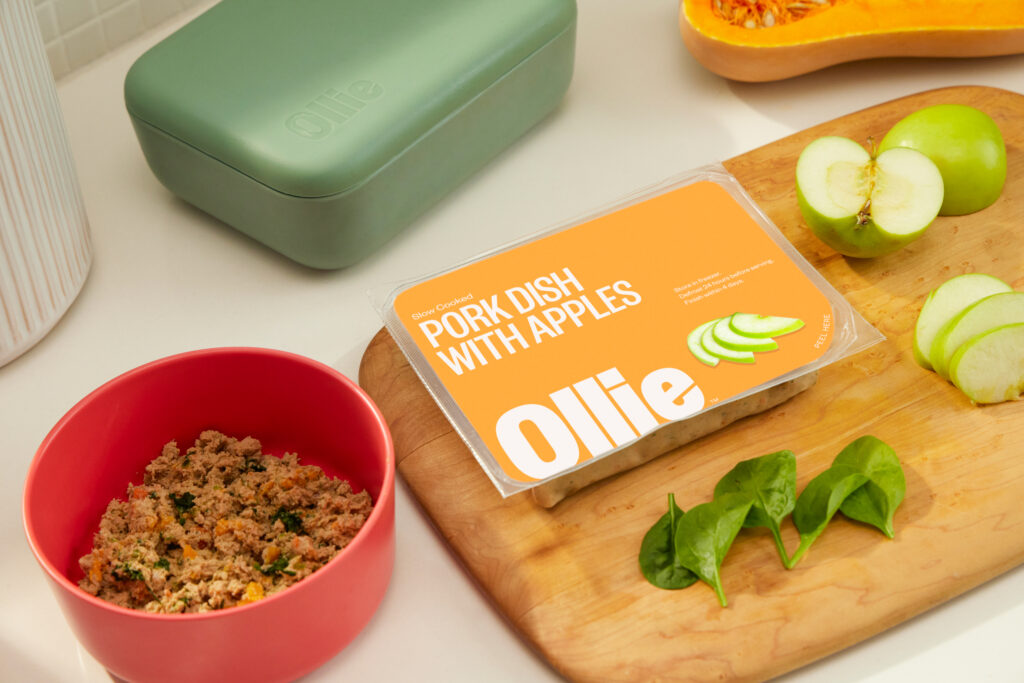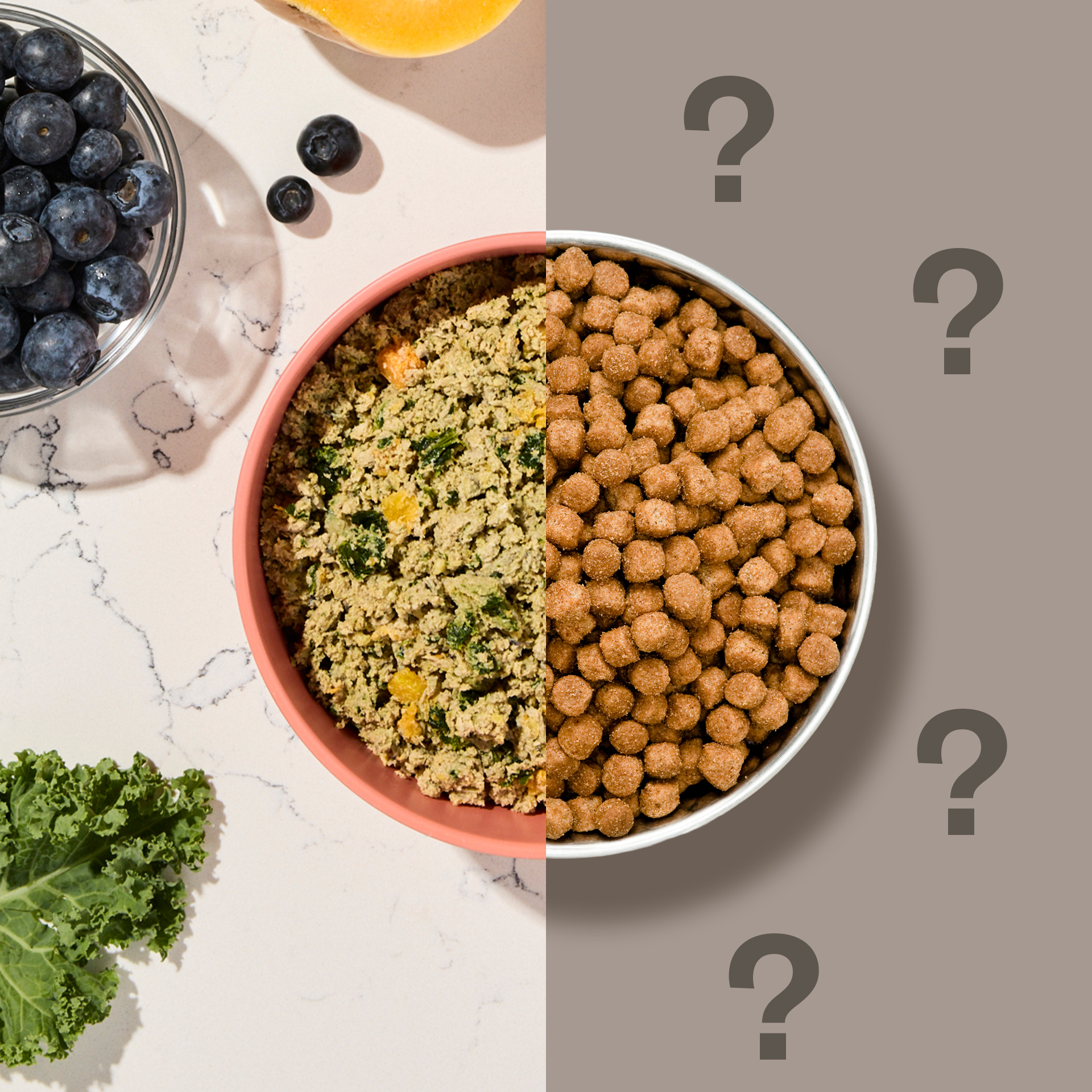Hey Ollie blog readers! We’re offering you an exclusive 60% OFF your starter box! Try now!
As pet parents, we know how important it is that our dogs live long, healthy, and happy lives. This is why at Ollie, we focus so much on what goes into their bowls. But did you know there may be something lurking in many processed pet foods that isn’t on the label, and it could be impacting your dog’s health long-term? These compounds are referred to as Advanced Glycation End Products (AGEs).
So what are AGEs and why should you care? Let’s dive in!
AGEs: The hidden compounds in your Pet’s Food
AGEs are harmful compounds that form when protein or fat combines with sugar during high-heat cooking. This is a process called the Maillard reaction and is responsible for the browning of meats and toasts, as well as the ultra-processing used in making dry and canned pet foods.
In other words, AGEs are a byproduct of cooking at high temperatures, which is typically used for extruded kibble or sterilizing canned foods. AGEs do not offer any nutritional value, and the buildup of AGEs has been linked to chronic inflammation, oxidative stress, and age-related diseases in both humans and animals.7,10

How can AGEs impact a pet’s health?
AGEs have been linked to a number of chronic illnesses in humans and animals. While research on pets is still growing, studies suggest excessive exposure to AGEs may contribute to:
- Kidney disease5.9
- Diabetes and insulin resistance4,9
- Heart disease6,9
- Joint inflammation and arthritis3
- Cognitive decline and aging1,2
AGEs also accumulate over time. Dogs that consume diets with excessive levels of AGEs may experience cumulative effects, especially as they age and become more susceptible.

How does fresh food compare?
Fresh pet food, gently cooked at lower temperatures, can contain significantly fewer AGEs. For instance, a 2020 study comparing processed pet foods against fresh dog food found that AGE levels were significantly higher in dry and canned products than in minimally processed meals.7 At Ollie, we believe that food should nourish and not harm our best friends. That’s why:
- Our food is gently cooked to preserve nutrients and minimize AGE formation
- We use whole ingredients —real meats, fresh veggies, and no byproduct meals or artificial preservatives
- Our meals are formulated with veterinary nutritionists, veterinarians, experts in pet nutrition, and food safety to ensure they are balanced and complete without unnecessary processing.
Reducing AGE exposure in your pet’s diet
Taking steps to reduce your dog’s exposure to AGEs is crucial for their overall well-being. A 2018 review showed that reduced AGE intake in humans led to measurable improvements in inflammatory markers and kidney function.7 While this study is based on humans, AGEs have similar impacts in pets, and the reduction of AGEs in your dog’s meals may support better metabolic health, protect organ function, and slow age-related decline.
Here’s what you can do to minimize AGEs while still feeding complete, nutritious meals:
- Limit ultra-processed foods
- Choose fresh, gently cooked options that emphasize lower temperature cooking and real ingredients
- Assess the ingredient list: avoid foods with “meat meals”, “byproduct meals” or excessive synthetic preservatives and dyes.

Your Dog Deserves Better
Just as we benefit from cleaner, less processed foods, so do our pets. By choosing fresh meals, you help reduce their exposure to potentially harmful compounds like AGEs. Our gently cooked recipes are designed to deliver real nutrition without the excess processing that contributes to AGE buildup.
Because when it comes to your best friend, fresh isn’t just a trend, it’s science-backed care. And making the switch to Ollie is an easy first step toward a healthier future.
Ready to see the difference fresh food can make? Try Ollie today and get 50% off your first box. Because a longer, healthier life starts with what’s in the bowl.
Reference List
- Akhter, F., Chen, D., Akhter, A., Sosunov, A. A., Chen, A., McKhann, G. M., Yan, S. F., & Yan, S. S. (2020). High dietary advanced glycation end products impair mitochondrial and cognitive function. Journal of Alzheimer’s Disease, 76(1), 165–178. https://doi.org/10.3233/JAD-191236
- Beeri, M. S., Lotan, R., Uribarri, J., Leurgans, S. E., Bennett, D. A., & Buchman, A. S. (2022).
Higher dietary intake of advanced glycation end products is associated with faster cognitive decline in community-dwelling older adults. Nutrients, 14(7), 1468. https://doi.org/10.3390/nu14071468 - Bridglalsingh, S., Archer-Hartmann, S., Azadi, P., Barbier de La Serre, C., Remillard, R. L., Sunvold, G. D., & Bartges, J. W. (2024). Association of four differently processed diets with plasma and urine advanced glycation end products and serum soluble receptor for advanced glycation end products concentration in healthy dogs. Journal of Animal Physiology and Animal Nutrition, 108(3), 735–751. https://doi.org/10.1111/jpn.13927
- Comazzi, S., Bertazzolo, W., Bonfanti, U., Spagnolo, V., & Sartorelli, P. (2008). Advanced glycation end products and sorbitol in blood from differently compensated diabetic dogs. Research in Veterinary Science, 84(3), 341–346. https://doi.org/10.1016/j.rvsc.2007.05.013
- Fotheringham, A. K., Gallo, L. A., Borg, D. J., & Forbes, J. M. (2022). Advanced glycation end products (AGEs) and chronic kidney disease: Does the modern diet AGE the kidney? Nutrients, 14(13), 2675. https://doi.org/10.3390/nu14132675
- Kilhovd, B. K., Juutilainen, A., Lehto, S., Rönnemaa, T., Torjesen, P. A., Birkeland, K. I., Berg, T. J., Hanssen, K. F., & Laakso, M. (2005). High serum levels of advanced glycation end products predict increased coronary heart disease mortality in nondiabetic women but not in nondiabetic men: A population-based 18-year follow-up study. Arteriosclerosis, Thrombosis, and Vascular Biology, 25(4), 815–820. https://doi.org/10.1161/01.ATV.0000158380.44231.fe
- Luevano-Contreras, C., & Chapman-Novakofski, K. (2018). Dietary advanced glycation end products and aging. Nutrients, 10(9), 1250. https://doi.org/10.3390/nu10091250
- Uribarri, J., Woodruff, S., Goodman, S., Cai, W., Chen, X., Pyzik, R., Yong, A., & Vlassara, H. (2020). Advanced glycation end products in foods and a practical guide to their reduction in the diet. Journal of Animal Science, 98(6), skaa172. https://doi.org/10.1093/jas/skaa172
- Uribarri, J., del Castillo, M. D., de la Maza, M. P., Filip, R., Gugliucci, A., Luevano-Contreras, C., Macías-Cervantes, M. H., Markowicz Bastos, D. H., Medrano, A., Menini, T., Portero-Otin, M., Rojas, A., Sampaio, G. R., Wrobel, K., Wrobel, K., & Garay-Sevilla, M. E. (2015). Dietary advanced glycation end products and their role in health and disease. Advances in Nutrition, 6(4), 461–473. https://doi.org/10.3945/an.115.008433
- Uribarri, J., Woodruff, S., Goodman, S., Cai, W., Chen, X., Pyzik, R., Yong, A., Striker, G. E., & Vlassara, H. (2010). Restriction of dietary AGEs reduces markers of oxidative stress and inflammation in humans. The Journal of Clinical Endocrinology & Metabolism, 95(9), 4496–4502. https://doi.org/10.1210/jc.2009-1925
Tagged As:

The nutrition your dog needs,
the food they want.

Enjoying our articles? Subscribe our Newsletters and get new articles directly to your inbox
You might also like
4 August 2025
5 MINS READ
Key Ingredients in Fresh Dog Food Explained
The right food starts with the right ingredients. Unlike highly processed kibble, which can contain fillers and low-quality by-products, fresh food focuses on transparency and quality. At Ollie, w…
by Ollie Pets
4 August 2025
6 MINS READ
Fresh Dog Food Benefits for Growing Puppies
Proper nutrition as a puppy is the foundation for a long, healthy, and happy life. Fresh, human-grade meals can support your puppy’s rapid growth, brain development, and long-term health in ways…
by Ollie Pets
4 August 2025
6 MINS READ
Choosing Specialized Dog Food: Solutions for Allergies and Sensitivities
There’s nothing more difficult than seeing your dog uncomfortable. Constant scratching, upset stomachs, or chronic ear infections can be signs that something in their diet isn’t agreeing with …
by Ollie Pets







